质谱技术简介及其在医学检验中的应用 ppt课件
合集下载
质谱检查项目 ppt课件
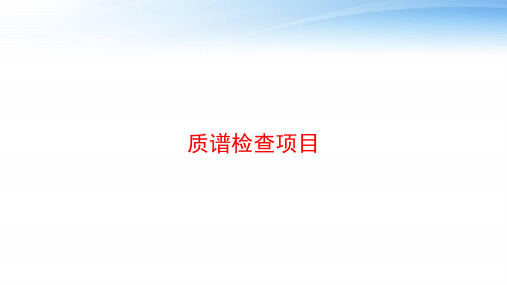
神经递质评估
检测方法不断升级
光谱法
比色法、紫外分光光度 法、荧光法等。灵敏度 比较低,特异性也不高, 检测数量有限,线性范 围比较窄
基本淘汰
免疫法
利用蛋白竞争的原理进行 监测的。放射免疫法、酶 免疫法、荧光免疫法、均 相酶免疫法等,方法样品 处理简单,获取时间较短, 临床用于评判疗效的一个 重要手段
常被误诊为高血压 未术前准备的患者手术死亡率高达50%
➢需筛查人群量大(高血压病 人等); ➢其他常规检查,如影像学等 难以发现; ➢筛出后可治愈率高。
儿茶酚胺
➢ 儿茶酚胺是一种含有儿茶酚(邻苯二酚)和 胺基的神经类物质。包括多巴胺、去甲肾上 腺素和肾上腺素及它们的衍生物
血药浓度测定方法的发展
我们的产品
质谱检测的优势
免疫 制剂
抗抑郁 药抗精 神病药
目前,同时检测几种血药浓度很低的免疫抑制剂(例如西罗莫司、依维莫司、他克莫 司和环孢素)是非常具有挑战性的。因此,采用灵敏度和特异性较高的UPLC-MS/MS 法同时监测是最正确的检测方法。
精神类药物常需要同时检测原型化合物和活性代谢物,不同药物间常具有相似的结构, 常规检测方法难度大。采用能够实现多指标同时检测的UPLC-MS/MS法监测是最有效 的检测方法。
☺VK专利
市场需求
☺社区医院
➢ 妊娠前6月需在社区医院建档,每月检查 ➢ 减轻社区医院药占比的压力
☺二级以上医院
➢ 提供孕产妇、儿童均衡衡营养需求依据 ➢ 提供有需求的亚健康人群检测,全科室覆盖 ➢ 弥补现有检测方法的不足
2 氨基酸谱检测
氨基酸的重要性
氨基酸是生命的基石,疾病与健康状况都与氨基酸有着直 接或间接的关联。氨基酸涉及代谢、肿瘤、免疫、心血管、 神经系统、肾病、糖尿病、亚健康、老年病等各类疾病和 人体生长发育、营养健康、肌肉骨骼生长、激素分泌、解 毒功能等各个健康环节。目前,氨基酸代谢障碍所引起的 疾病已超过400多种。氨基酸的检测已经成为健康诊断和 疾病筛查的重要手段,同时又可以作为各类人群治疗、营
十七章-质谱法PPT课件(2024版)

(一)分子离子(molecularion)
1.分子离子峰定义的表示方法 分子受电子流冲击后,失去一个电子形成的离
子即为分子离子,所产生的峰称为分子离子峰或母峰, 用M、M+、 表示 .
M + e → +2e
M -e M·+
①奇数个电子 ②谱图最右端 ③确定分子量
(一)分子离子(molecularion)
➢ 易获得有关化合物官能团的信息
➢ 谱图简单;
缺点:
+
➢ 重现性较差;
+
➢ 样品需要加热气化后进行 离子化,故不适合于难挥发、 热不稳定化合物的分析。
气体分子
试样分子
+ 准分子离子
电子
(M+1)+;(M+17) +;(M+29) +;
场致电离源(FI)
• 阳极和阴极之间,施加 高电压(10~20kv)时, 阳极的尖端附近产生强 电场,利用这个强电场 可将接近尖端的气态样 品分子中的电子拉走, 形成正离子。
1.分子离子峰定义的表示方法
失去电子的顺序:杂原子上n电子﹥π电子 ﹥ C-C键上的σ电子﹥ C-H键上的σ电子
杂原子>C=C>C-C>C-H(难)
如:R-C=O-R‘失去n电子(9.8ev);失去π电 子(10.6ev);失去σ电子(11.5ev指C-Cσ电子)
•
表示一对电子失去了一个电子,形成具有
(三) 离子源
离子源也叫离子化室。
1.离子源的作用有两个方面: 将被分析的样品电离成离子; 把正离子引出,加速和聚焦。 2.对有机物最常用的电离方法有:
电子轰击源(EI) 化学电离源(CI) 场致电离源(FD) 快速原子轰击离子源(FAB) 光电离源(PI)等
质谱技术在医学检验中的应用39页PPT
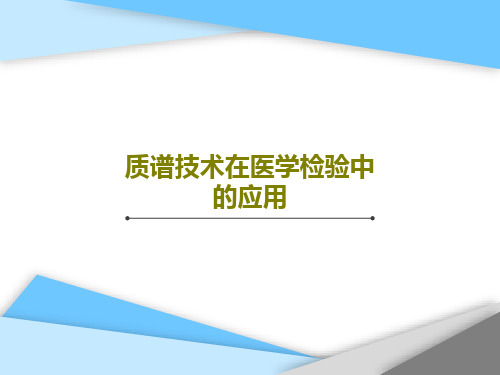
质谱技术在医学检验中 的应用
6、纪律是自由的第一条件。——黑格 尔 7、纪律是集体的面貌,集体的声音, 集体的 动作, 集体的 表情, 集体的 信念。 ——马 卡连柯
8、我们现在必须完全保持党的纪律, 否则一 切都会 陷入污 泥中。 ——马 克思 9、学校没有纪律便如磨坊没有水。— —夸美 纽斯
10、一个人应该:活泼而守纪律,天 真而不 幼稚, 勇敢而 鲁莽, 倔强而 有原则 ,热情 而不冲 动,乐 观而不 盲目。 ——马 克思
61、奢侈是舒适的,否则就不是奢侈 。——CocoCha nel 62、少而好学,如日出之阳;壮而好学 ,如日 中之光 ;志而 好学, 如炳烛 之光。 ——刘 向 63、三军可夺帅也,匹夫不可夺志也。 ——孔 丘 64、人生就是学校。在那里,与其说好 的教师 是幸福 ,不如 说好的 教师是 不幸。 ——海 贝尔 65、接受挑战,就可以享受胜利的喜悦 。——杰纳勒 尔·乔治·S·巴顿
Hale Waihona Puke 谢谢!
6、纪律是自由的第一条件。——黑格 尔 7、纪律是集体的面貌,集体的声音, 集体的 动作, 集体的 表情, 集体的 信念。 ——马 卡连柯
8、我们现在必须完全保持党的纪律, 否则一 切都会 陷入污 泥中。 ——马 克思 9、学校没有纪律便如磨坊没有水。— —夸美 纽斯
10、一个人应该:活泼而守纪律,天 真而不 幼稚, 勇敢而 鲁莽, 倔强而 有原则 ,热情 而不冲 动,乐 观而不 盲目。 ——马 克思
61、奢侈是舒适的,否则就不是奢侈 。——CocoCha nel 62、少而好学,如日出之阳;壮而好学 ,如日 中之光 ;志而 好学, 如炳烛 之光。 ——刘 向 63、三军可夺帅也,匹夫不可夺志也。 ——孔 丘 64、人生就是学校。在那里,与其说好 的教师 是幸福 ,不如 说好的 教师是 不幸。 ——海 贝尔 65、接受挑战,就可以享受胜利的喜悦 。——杰纳勒 尔·乔治·S·巴顿
Hale Waihona Puke 谢谢!
质谱法专业知识课件
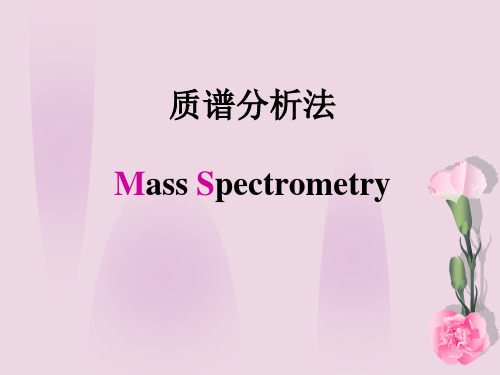
在离子源内,用电加热铼或钨旳灯丝到2023℃,产生高速电子 束,其能量为10~7OeV。当气态试样由分子漏入孔进入电离室 时,高速电子与分子发生碰撞,若电子旳能量不小于试样分子 旳电离电位,将造成试样分子旳电离。
碎片离子可用于有机化合物旳构造鉴定
优点: 1)稳定, 质谱图再现性好,便于计算机检索及比较; 2)离子碎片多,可提供较多旳分子构造信息。 缺陷:
4)基质辅助激光解吸离子源(MALDI)
原理:是用激光照射样品与基质形成旳共结晶薄膜,基质从 激光中吸收能量传递给样品,从而使样品解吸和电离旳过程。 它是一种软电离技术,合用于混合物及生物大分子旳测定。
(3)质量分析器
质谱仪旳质量分析器位于离子源和检测器之间。
作用 :过滤
质量分析器旳主要类型有:磁分析器、飞行时间质量分 析器、离子阱质量分析器和四级杆质量分析器等。
质谱能做什么?
定性:化合物旳构造。 定量:混合物旳各构成含量。 领域:化学、生物学、医学、药学、环境、物理、材料、能源 等。
质谱分析法旳特点
➢(1)应用范围广。测定样品能够是无机物,也能够是有 机物。被分析旳样品能够是气体和液体,也能够是固体。 ➢(2)敏捷度高,样品用量少。目前有机质谱仪旳绝对敏 捷度可达50pg(pg为10−12g),无机质谱仪绝对敏捷度可 达10−14 g。用微克级样品即可得到满意旳分析成果。 ➢(3)分析速度快,并可实现多组分同步测定。 ➢(4)与其他仪器相比,仪器构造复杂,价格昂贵,使用 及维修比较困难。对样品有破坏性。
在一般有机分子鉴定时,能够经过同位素离子峰相对强度之 比来拟定其元素构成。
➢例如:CH4 M=16
➢12C+1H×4=16
M
➢13C+1H×4=17 M+1
质谱分析技术-PPT课件

5) 另外分子量测定还可以提供分子结构信息: (1)分子式(样品的元素组成)用同位素丰度比法 (低分辨法)或高分辨质谱仪测得的准确相对分子质 量,均可以确定分子式; (2)鉴定某些官能团如甲基(m/z 15)、羰基(m/z 28)、 甲氧基(m/z 31)、乙酰基(m/z 43)…… (3)分子结构信息由分子结构与裂解方式的经验规 律,根据碎片离子的m/z 及相对丰度RA 提供分子结构 信息。
2)SELDI-TOF MS Surface Enhanced Laser Desorption/Ionization 表面增强激光解吸附离子化 MW: 2,000-50,000
3)MS/MS Tandem MS串连质谱技术 MW: 200-3,000
1)MALDI-TOF MS (原理示意图)
The following components are ACCEPTABLE Acetic or formic acid, Acetonitrile, ethanol,
Guanidine/HCl 4M,
Hexafluoroisopropanol up to 40%, Methanol, Sodium chloride 10 mM,
Urea 1M
八、质谱数据分析软件使用 (以Mascot为例) ExPASy Proteomics Tools
Matrix Science主页
PMF分析 MS/MS分析
GLSDGEWQQVLNVWGK VEADIAGHGQEVLIR LFTGHPETLEK HGTVVLTALGGILK KGHHEAELKPLAQSHATK GHHEAELKPLAQSHATK YLEFISDAIIHVLHSK HPGDFGADAQGAMTK ALELFR
ALELFR
2)SELDI-TOF MS Surface Enhanced Laser Desorption/Ionization 表面增强激光解吸附离子化 MW: 2,000-50,000
3)MS/MS Tandem MS串连质谱技术 MW: 200-3,000
1)MALDI-TOF MS (原理示意图)
The following components are ACCEPTABLE Acetic or formic acid, Acetonitrile, ethanol,
Guanidine/HCl 4M,
Hexafluoroisopropanol up to 40%, Methanol, Sodium chloride 10 mM,
Urea 1M
八、质谱数据分析软件使用 (以Mascot为例) ExPASy Proteomics Tools
Matrix Science主页
PMF分析 MS/MS分析
GLSDGEWQQVLNVWGK VEADIAGHGQEVLIR LFTGHPETLEK HGTVVLTALGGILK KGHHEAELKPLAQSHATK GHHEAELKPLAQSHATK YLEFISDAIIHVLHSK HPGDFGADAQGAMTK ALELFR
ALELFR
(医学课件)质谱技术在检验医学领域的应用

03
检验医学领域质谱技术的发展趋势
质谱技术在国内检验医学领域的发展现状
临床质谱实验室规范化建设
加强临床质谱实验室的规范化建设,包括硬件设施、人员培训、质量控制等方面的提升。
临床需求驱动
以临床需求为导向,开发和应用新的质谱技术,以满足临床诊疗和科研的需求。
技术创新和转化
加强技术创新和转化,提高质谱技术的检测性能和实用性,推动其在临床医学检验领域的应用。
提供更多可能性。
技术创新
未来质谱技术将与其它分析技 术结合,如免疫分析、色谱、 光谱等,实现更高效、灵敏的
分析和检测。
对检验医学领域质谱技术的建议和期望
加强技术应用
人才培养
建议在检验医学领域加强质谱技术的推广和 应用,特别是在临床常规检测和诊断中,充 分发挥其高精度、高灵敏度的优势。
加强质谱技术人才的培养,提高检验医学领 域专业人员的技能水平,以满足临床需求和 提高医学检验质量。
《医学课件》质谱技术在检 验医学领域的应用
xx年xx月xx日
contents
目录
• 质谱技术的基本原理 • 质谱技术在检验医学领域的应用 • 检验医学领域质谱技术的发展趋势 • 结论与展望
01
质谱技术的基本原理
质谱技术的简介
质谱技术是一种通过离子化样品并测量其质量电荷比(m/z )来获得样品分子量信息的分析方法。
质谱技术在检验医学领域的应用
质谱技术在蛋白质组学研究中的应用
蛋白质组学研究是质谱技术应用的重要领域之一,质谱技术 在蛋白质鉴定、定量分析和结构分析等方面具有重要作用。
质谱技术可以鉴定蛋白质复合物,研究蛋白质之间的相互作 用,揭示疾病的发生发展与蛋白质变化的关系,为新药发现 和疾病诊断提供依据。
质谱全介绍ppt课件

液相色谱—质谱联用的原理及应用
中心实验室
;.
1
简介
色谱质谱的在线联用将色谱的分离能力与质谱的定性功能结合起来,实 现对复杂混合物更准确的定量和定性分析。而且也简化了样品的前处理 过程,使样品分析更简便。
色谱质谱联用包括气相色谱质谱联用(GC-MS)和液相色谱质谱联用(LCMS),液质联用与气质联用互为补充,分析不同性质的化合物。
1 4 7 7 2 9 .0 0
146500
147000
147500 Mass, amu
148000
148500
16
149000
同位素离子
由元素的重同位素构成的离子称为同位素离子. 各种元素的同位素,基本上按照其在自然界的丰度比出现在质谱中,这对
于利用质谱确定化合物及碎片的元素组成有很大方便, 还可利用稳定同 位素合成标记化合物,如:氘等标记化合物,再用质谱法检出这些化合物, 在质谱图外貌上无变化,只是质量数的位移,从而说明化合物结构,反应历 程等
;.
20
不同类型有机物有不同的裂解方式 相同类型有机物有相同的裂解方式,只是质量数的差异 需要经验记忆。
;.
21
质谱解析的一般步骤
(适于低分辨小分子谱图,若已经是高分辨质谱图得到元素组成更好) (1)核对获得的谱图,扣除本底等因素引起的失真,考虑操作条件是否适当 (2)综合样品其他知识:例如熔点,沸点,溶解性等理化性质,样品来源,
APCI(Atmospheric Pressure Chemical Ionization):大气压化学电离—同上, 更适宜做弱极性小分子。
APPI(Atmospheric Pressure PhotoSpray Ionization):大气压光喷雾电离—同上, 更适宜做非极性分子。
中心实验室
;.
1
简介
色谱质谱的在线联用将色谱的分离能力与质谱的定性功能结合起来,实 现对复杂混合物更准确的定量和定性分析。而且也简化了样品的前处理 过程,使样品分析更简便。
色谱质谱联用包括气相色谱质谱联用(GC-MS)和液相色谱质谱联用(LCMS),液质联用与气质联用互为补充,分析不同性质的化合物。
1 4 7 7 2 9 .0 0
146500
147000
147500 Mass, amu
148000
148500
16
149000
同位素离子
由元素的重同位素构成的离子称为同位素离子. 各种元素的同位素,基本上按照其在自然界的丰度比出现在质谱中,这对
于利用质谱确定化合物及碎片的元素组成有很大方便, 还可利用稳定同 位素合成标记化合物,如:氘等标记化合物,再用质谱法检出这些化合物, 在质谱图外貌上无变化,只是质量数的位移,从而说明化合物结构,反应历 程等
;.
20
不同类型有机物有不同的裂解方式 相同类型有机物有相同的裂解方式,只是质量数的差异 需要经验记忆。
;.
21
质谱解析的一般步骤
(适于低分辨小分子谱图,若已经是高分辨质谱图得到元素组成更好) (1)核对获得的谱图,扣除本底等因素引起的失真,考虑操作条件是否适当 (2)综合样品其他知识:例如熔点,沸点,溶解性等理化性质,样品来源,
APCI(Atmospheric Pressure Chemical Ionization):大气压化学电离—同上, 更适宜做弱极性小分子。
APPI(Atmospheric Pressure PhotoSpray Ionization):大气压光喷雾电离—同上, 更适宜做非极性分子。
(医学课件)质谱技术在检验医学领域的应用

通过对其质谱图的解析,可以得到样品的分子结构信息。
02
环境分析
质谱技术可用于环境分析,如空气、水、土壤中污染物的检测,通过
对其质谱图的解析,可以得到污染物的分子结构信息。
03
生物医学分析
质谱技术可用于生物医学分析,如蛋白质、核酸、细胞等生物样品的
检测,通过对其质谱图的解析,可以得到生物样品的分子结构信息,
03
个性化治疗及药物研发
质谱技术可用于研究药物的代谢和作用机制,为个性化治疗及药物研
发提供支持。
,可以应用于疾病早期诊断及病情监测
1 2
遗传性疾病
质谱技术可检测遗传性疾病相关基因突变,有 助于遗传性疾病的早期诊断和产前筛查。
感染性疾病
质谱技术可快速检测细菌、病毒等微生物,为 感染性疾病的诊断和治疗提供依据。
随着技术的不断创新,质谱的灵敏度不断提高,可检测低至皮克级和飞克级。
质谱技术在检验医学领域的应用前景
01
临床应用范围广
质谱技术在临床检验中具有广泛的应用前景,可检测多种生物分子和
离子,为诊断和治疗提供依据。
02
疾病早期诊断及病情监测
质谱技术可检测多种疾病相关生物分子,有助于疾病的早期诊断及病
情监测。
高度特异性
质谱技术具有很高的特异性,可以 对不同的生物分子进行精确的定性 和定量分析。
快速高效
随着质谱技术的不断进步,分析速 度已经得到了大幅提升,大大缩短 了检测时间。
质谱技术的缺点
成本较高
01
与传统的检测方法相比,质谱技术的设备成本较高,需要专业
的技术人员操作和维护。
对样品要求高
02
质谱技术需要高质量的样品才能得到可靠的检测结果,对于某
质谱技术在检验医学领域的应用

疗效监测和预后判断
通过监测患者治疗过程中的分子变化,评估疗效和预测预后。
推动精准医疗发展
医学研究
通过质谱技术深入了解疾病的发生发展机制,为药物研发提供靶点。
新药研发
利用质谱技术进行药物筛选、药效评估和毒性检测,加速药物研发进程。
促进医学研究与新药研发
质谱技术在检验医学领域的前景
04
临床医生对疾病诊断和治疗的需求不断提高,需要更准确、更快速、更灵敏的检测方法。
质谱技术分为多种类型,如磁场质谱、飞行时间质谱、离子阱质谱、傅里叶变换质谱等。不同类型的质谱仪具有不同的分辨率、灵敏度和应用范围域。
在医学领域中,质谱技术被用于临床诊断、药物研发、生物标志物发现等。例如,质谱技术可以用于检测血液中的氨基酸、蛋白质、肽段、核酸和脂肪酸等生物标志物,以帮助诊断疾病和评估治疗效果。
质谱技术的应用范围
质谱技术在检验医学领域的应用
02
1
临床疾病诊断与鉴别诊断
2
3
通过检测生物标志物,如病毒和细菌抗原、抗体等,为感染性疾病提供快速、准确的诊断依据。
感染性疾病诊断
通过检测肿瘤相关标志物,如癌胚抗原、前列腺特异性抗原等,辅助肿瘤的早期发现与诊断。
肿瘤筛查与诊断
通过检测基因多态性等生物标志物,为患者制定个性化治疗方案提供依据。
疾病机制研究
生物标志物发现与验证
药物研发与优化
医学研究与发现
质谱技术在检验医学领域的影响
03
1
提高疾病诊断准确性
2
3
蛋白质质谱用于诊断癌症、自身免疫性疾病和神经系统疾病等。
核酸质谱用于检测基因突变和遗传性疾病。
代谢组学质谱用于发现生物标志物,为疾病早期诊断提供依据。
通过监测患者治疗过程中的分子变化,评估疗效和预测预后。
推动精准医疗发展
医学研究
通过质谱技术深入了解疾病的发生发展机制,为药物研发提供靶点。
新药研发
利用质谱技术进行药物筛选、药效评估和毒性检测,加速药物研发进程。
促进医学研究与新药研发
质谱技术在检验医学领域的前景
04
临床医生对疾病诊断和治疗的需求不断提高,需要更准确、更快速、更灵敏的检测方法。
质谱技术分为多种类型,如磁场质谱、飞行时间质谱、离子阱质谱、傅里叶变换质谱等。不同类型的质谱仪具有不同的分辨率、灵敏度和应用范围域。
在医学领域中,质谱技术被用于临床诊断、药物研发、生物标志物发现等。例如,质谱技术可以用于检测血液中的氨基酸、蛋白质、肽段、核酸和脂肪酸等生物标志物,以帮助诊断疾病和评估治疗效果。
质谱技术的应用范围
质谱技术在检验医学领域的应用
02
1
临床疾病诊断与鉴别诊断
2
3
通过检测生物标志物,如病毒和细菌抗原、抗体等,为感染性疾病提供快速、准确的诊断依据。
感染性疾病诊断
通过检测肿瘤相关标志物,如癌胚抗原、前列腺特异性抗原等,辅助肿瘤的早期发现与诊断。
肿瘤筛查与诊断
通过检测基因多态性等生物标志物,为患者制定个性化治疗方案提供依据。
疾病机制研究
生物标志物发现与验证
药物研发与优化
医学研究与发现
质谱技术在检验医学领域的影响
03
1
提高疾病诊断准确性
2
3
蛋白质质谱用于诊断癌症、自身免疫性疾病和神经系统疾病等。
核酸质谱用于检测基因突变和遗传性疾病。
代谢组学质谱用于发现生物标志物,为疾病早期诊断提供依据。
质谱技术在临床微生物检验中的应用

真菌毒素检测
某些真菌可以产生毒素,质谱技术可 以检测这些毒素的成分和含量,有助 于评估真菌毒素对人体的危害。
04
质谱技术在临床微生物检验中的挑战与展望
标准化和规范化问题
缺乏统一的质谱技术标准和操作规范:不同实验室之间的结 果可比性差,影响临床诊断和治疗。
需建立标准化的实验流程和质控体系:确保实验结果的准确 性和可靠性。
80%
细菌分型与溯源
质谱技术可以对同种细菌的不同 菌株进行分型,有助于追踪感染 源和传播途径,控制疫情的扩散 。
质谱技术在病毒鉴定中的应用
病毒种属鉴定
通过对病毒的蛋白质组进行分 析,质谱技术可以快速鉴定病 毒的种属,有助于病毒性疾病 的诊断。
病毒变异分析
质谱技术可以检测病毒基因的 突变,从而分析病毒的变异情 况,为抗病毒药物的研发和疫 苗的研制提供依据。
03
质谱技术在临床微生物检验中的应用实例
质谱技术在细菌鉴定中的应用
80%
鉴定细菌种类
质谱技术通过对细菌的肽指纹图 谱进行分析,可以快速准确地鉴 定出细菌的种类,为临床诊断和 治疗提供依据。
ห้องสมุดไป่ตู้
100%
耐药性分析
质谱技术可以检测细菌的耐药性 相关蛋白,从而判断细菌对抗生 素的耐药性,有助于指导临床合 理用药。
临床应用的适应症和样本类型
需要进一步明确质谱技术在不同适应症和样本类型中的应用范围和优势。
未来发展方向和前景
加强基础研究和临床应用研究
01
深入研究和探索质谱技术在临床微生物检验中的潜力和应用前
景。
促进多学科交叉合作
02
加强与临床医学、药学、生物信息学等学科的交叉合作,共同
(医学课件)质谱技术在检验医学领域的应用
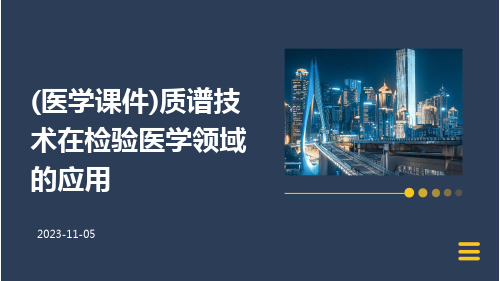
04
质谱技术在检验医学领域的优 势与挑战
质谱技术的优势
精度高
灵敏度高
质谱技术可以高精度地测定元素或化合物的 质量,有助于准确鉴别和定量分析生物样品 中的目标化合物。
现代质谱技术可以检测到低至ppt级别的物 质,对于痕量级成分的检测尤为适用。
速度快
无需标记
质谱技术可以实现快速分析,对于大量样品 的处理效率较高。
案例二:质谱技术在肿瘤诊断中的实际应用
总结词
质谱技术在肿瘤诊断中具有广泛的应用价值,能够检测 肿瘤特异性标志物,提高肿瘤诊断的准确性和灵敏度。
详细描述
质谱技术可以用于检测生物样本中的肿瘤特异性标志物 ,如癌胚抗原、糖类抗原等,从而对肿瘤进行早期诊断 和预后评估。此外,质谱技术还可以用于检测肿瘤细胞 的代谢产物和蛋白质组学差异,为肿瘤的精准诊断和治 疗提供依据。例如,对于结肠癌患者,通过质谱技术检 测血液中的癌胚抗原水平,可以早期发现肿瘤并指导手 术治疗。
。
人工智能辅助分析
结合人工智能和机器学习技术,质谱数据 分析可能会实现更精准和高效的辅助诊断 与决策支持功能。
05
案例分析
案例一
要点一
总结词
质谱技术在感染性疾病诊断中具有重要作用,能够快速 、准确地检测病原体,提高诊断效率。
要点二
详细描述
质谱技术是一种基于质谱原理的检测方法,能够快速、 准确地检测生物样本中的蛋白质、多肽、代谢物等组分 。在感染性疾病诊断中,质谱技术可以用于检测病原体 的特异性蛋白或代谢物,从而快速确定病原体种类,指 导临床治疗。例如,对于细菌性肺炎患者,通过质谱技 术检测痰液中的细菌蛋白,可以快速诊断并指导抗生素 使用。
质谱技术在肿瘤诊断与鉴别诊断中的应用
质谱技术在检验医学领域的应用课件
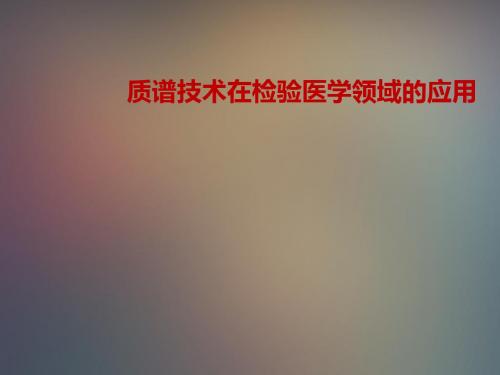
ICP-MS原理图
ICP离子源
接口锥
炬管
样品锥
流动相 进样器
预柱
HPLC
泵
雾化器
雾化腔
HPLC-色谱柱
离子透镜
四级杆质谱
四级杆质量 分析器
干扰消除部件— 碰撞反应池
监测器 检测器
待测粒子的流向
样品导入系统
ICP-MS分析过程
液体样品雾化过程
固体样品
气溶胶
吸收过程
去溶过程
粒子
原子化
分子 蒸发过程
代谢组学
代谢组学的研究就是运用一系列分析化学手段,如色谱、质谱、核磁共振 、光谱等,通过分析生物体液、组织中的内源性代谢产物谱的变化来研究 整体的生物学状况和基因功能调节;
作为系统生物学的重要组成部分,代谢组学已经成为继基因组学、转录组 学、蛋白质组学之后兴起的一个新的组学研究热点;
与基因组学、蛋白质组学相比,代谢组学研究的是已经发生的改变,而前 两者研究的是可能发生的改变,因此在这个意义上说,代谢组学更接近于 临床。
原子
离
电离过程 子
发射过程
Mass
+
analyzer
样品蒸发、解离、原子化、电离等过程
电子脉冲
电子倍增器电极
+ 来自质量分析器的离子
核工业: 5% •核燃料的分析 •放射性同位素的分析 •初级冷却水的污染分析
地质学: 2% •金属材料,合金等 •土壤、矿石、沉积物 •同位素比的研究 •激光熔蚀直接分析固 体样品
半导体: 33% •高纯金属(电极) •高纯试剂(酸,碱,有机) •Si 晶片的超痕量杂质 •光刻胶和清洗剂
Page
检验医学领域应用
质谱技术简介及其在医学检验中的应用 ppt课件
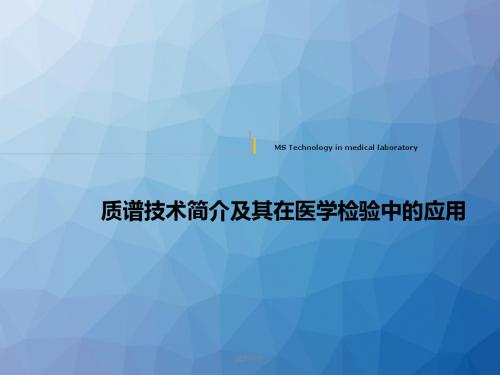
• 1、分辨率低。 • 2、1000Da以下基质峰干扰。 • 3、激光解吸附离子化有可能使样 品光降解。 • 4、串联质谱功能较弱,除非接反 射装置进行源后衰变测量。 • 5、不能分析非共价键相互作用。 • 6、定量时需要内校准。 • 7、如没有反射飞行装置,不能分 析多肽修饰。 • 8、对各种赋形剂的容忍度低(如 • 含磷酸缓冲液,大于150mM的盐 等。
MS Technology in medical laboratory
质谱技术简介及其在医学检验中的应用
ppt课件
质谱 • 光谱
通常医学检验方法是基于光谱的分析。 质谱是运用电磁学原理,对荷电分子、亚稳 分子碎片进行分离、分析,与光谱学分析完全 不同。 随着质谱技术的发展,质谱在质检、环境、
检 测 器
EI源 FAB源 MALDI源
Quadruopole
电子倍增器
Ion trap
Time-of-flight
闪烁计数器
ESI源
ppt课件
质谱计构造:真空系统
• 离子源和质量分析器的真空度需保持在 10–4 ~ 10–5 Pa和10–5 ~ 10–6 Pa。 因为: – 大量氧会烧坏离子源的灯丝; – 用作加速离子的几千伏高压会引起放电; – 引起额外的离子-分子反应,改变裂解模型, 谱图复杂化。
ppt课件
MALDI技术中基质的作用
把样品分子彼此分开(基质:样品=10,000:1),削弱 样品分子之间的相互作用。 基质吸收激光的能量,并将部分能量传递给样品。 帮助样品离子化。
ppt课件
C: MALDI 激光解吸附离子源 Matrix-Assisted laser Desorption/Ionization
• 优点
MS Technology in medical laboratory
质谱技术简介及其在医学检验中的应用
ppt课件
质谱 • 光谱
通常医学检验方法是基于光谱的分析。 质谱是运用电磁学原理,对荷电分子、亚稳 分子碎片进行分离、分析,与光谱学分析完全 不同。 随着质谱技术的发展,质谱在质检、环境、
检 测 器
EI源 FAB源 MALDI源
Quadruopole
电子倍增器
Ion trap
Time-of-flight
闪烁计数器
ESI源
ppt课件
质谱计构造:真空系统
• 离子源和质量分析器的真空度需保持在 10–4 ~ 10–5 Pa和10–5 ~ 10–6 Pa。 因为: – 大量氧会烧坏离子源的灯丝; – 用作加速离子的几千伏高压会引起放电; – 引起额外的离子-分子反应,改变裂解模型, 谱图复杂化。
ppt课件
MALDI技术中基质的作用
把样品分子彼此分开(基质:样品=10,000:1),削弱 样品分子之间的相互作用。 基质吸收激光的能量,并将部分能量传递给样品。 帮助样品离子化。
ppt课件
C: MALDI 激光解吸附离子源 Matrix-Assisted laser Desorption/Ionization
• 优点
《质谱原理及应用》PPT课件

特征:(裂解方式与醇相似)
a、脂肪醚的M很弱,芳香醚的M较强;增大样品用量或增大操作压力,可
醚 使M及M+1峰增强;
b、脂肪醚主要有三种裂解方式(Cα-Cβ键裂解、O-Cα键裂解、重排α裂 解);
c、芳香醚只发生O-Cα键裂解;
d、缩醛是一类特殊的醚,中心碳原子的四个键都可裂解,概率相差无几;
e、环醚裂解脱去中性碎片醛。
1.09
根据“氮规则”、M=181,化合物分子式为(2)。
+
CH3CH2CH2CH2CH2CH3
CH3CH2CH2CH2CH2+ + CH3 m/e 71
CH3CH2CH2CH2+ + CH2CH3 m/e 57
CH3CH2CH2+ + CH2CH2CH3 m/e 43
CH3CH2+ + CH2CH2CH2CH3 m/e 29
CH3 m/e 137 (M +)
CH3CH2CH2COOHm/e88(M +)
NO2
试判断下列化合物的分子离子峰的质荷比是偶数还是奇数?
(i)C H 3 I(ii)C H 3 C N (iii)C 2 H 5 N H 2(iv )H 2 N C H 2 C H 2 N H 2(v ) N H
同位素离子
e、环状酮可能发生较为复杂的裂解(但仍以酮基α 裂解开始)。
羧基
特征:
a、脂肪羧酸的M峰一般可察出,最特征的峰为m/z=60峰,由McLafferty 重排裂解产生;
b、芳香族羧酸的M峰相当强,M-17,M-45峰也较明显。
羧酸酯
特征: a、直链一元羧酸酯的M峰通常可观察到,且随相对分子质量的增高(C6)
- 1、下载文档前请自行甄别文档内容的完整性,平台不提供额外的编辑、内容补充、找答案等附加服务。
- 2、"仅部分预览"的文档,不可在线预览部分如存在完整性等问题,可反馈申请退款(可完整预览的文档不适用该条件!)。
- 3、如文档侵犯您的权益,请联系客服反馈,我们会尽快为您处理(人工客服工作时间:9:00-18:30)。
50-70eV M+ e
-M +. + 2e
M . 小于1%
+.
A +. +
M
B + + R.
中性分子或碎片
C +. D+
Tianjin First Center Hospital
质量分析器
◆ 质量分析器是质谱计的核心 ◆ 不同类型的质量分析器构成不同类型的质谱计 ◆ 不同类型的质谱计其功能,应用范围,原理,
Tianjin First Center Hospital
质谱的特征
准确 快速 高通量 微量 检测成本低 能够分析分子结构
Tianjin First Center Hospital
目录 CONTENT
Tianjin First Center Hospital
目录 CONTENT
Tianjin First Center Hospital
质谱技术简介及其在医学检验中的应 用
MS Technology in medical laboratory
质谱技术简介及其在医学检验中的应用
质谱 • 光谱
通常医学检验方法是基于光谱的分析。 质谱是运用电磁学原理,对荷电分子、亚稳 分子碎片进行分离、分析,与光谱学分析完全 不同。 随着质谱技术的发展,质谱在质检、环境、 临床检验中的应用越来越广泛。
Sample
Ceramic tip
V acuum s e a ls
Tianjin First Center Hospital
Sample Introduction: Gas Chromatogram-MS (GCMS)
• GC output to mass spectrometer
• Sample already in gas phase
Sample+ He from GC
He Vacuum
pum p
Sample ToMS
Tianjin First Center Hospital
Sample Introduction: Liquid Chromatogram-MS (LC-MS)
• Direct infusion of sample in solution
实验方法均有所不同。
Tianjin First Center Hospital
检测记录系统
质量分析器分离并加以聚焦的离子束,
按m/z的大小依次通过狭缝,到达收集器。
经接收放大后被记录。
Tianjin First Center Hospital
离子化的方法
电子轰击电离 Electron Impact Ionization, EI 化学离子化 Chemical Ionization, CI 场电离,场解吸 Field Ionization FD, Field Desorption FD 快原子轰击 Fast Atom Bombardment, FAB 基质辅助激光解析电离 Matrix-Assisted Laser Desorption
• Syringe pump: slow steady infusion
• Output from HPLC
• Separation and identification of components
• Vast majority of solution is solvent
• Must remove solvent to “see” analyte
质谱仪是按照离子的质荷比(m/z)不同,来分离不同分子量 的分子.测定分子量进行成分和结构分析.
离子的生成方式有失去或捕获电荷(如:电子发射,质子化或 去质子化)
Tianjin First Center Hospital
质谱计框图
真空系统
加速区
Output
计算机数据 处理系统
进样系统
Samplห้องสมุดไป่ตู้ inlet
因为: – 大量氧会烧坏离子源的灯丝; – 用作加速离子的几千伏高压会引起放电; – 引起额外的离子-分子反应,改变裂解模型, 谱图复杂化。
Tianjin First Center Hospital
进样系统
• 在不破坏真空度的情况下,使样品进入离子源。 • 气体可通过储气器进入离子源。 • 易挥发的液体,在进样系统内汽化后进入离子
• Historically: extra pumping and heating
• Applicable to electrospray ionisation
• ESI: see later
Tianjin First Center Hospital
离子源
分子失去电子,生成带正电荷的分子离子
分子离子可进一步裂解,生成质量更小的碎片离子
源。 • 难挥发的液体或固体样品,通过探针直接插入
离子源。
Tianjin First Center Hospital
Sample Introduction: (直接进样杆) Direct Insertion Probe (DIP)
• Direct insertion probe
• Conceptually very easy, practically very tricky
++
: R1
Ionization, MALDI 电喷雾电离 Electrospray Ionization, ESI 大气压化学电离 Atmospheric Pressure Chemical Ionization,
APCI
Tianjin First Center Hospital
电子轰击电离
Electron Impact (EI)
+
EI源 FAB源 MALDI源 ESI源
Quadruopole Ion trap Time-of-flight
检 测 器
电子倍增器 闪烁计数器
Tianjin First Center Hospital
质谱计构造:真空系统
• 离子源和质量分析器的真空度需保持在 10–4 ~ 10–5 Pa和10–5 ~ 10–6 Pa。
Ionisation
离子源
source
质量分析器 Ion separation
检测器
Detector
Tianjin First Center Hospital
离子源
质量过滤/分析器
进样部分 样品板 LC或GC
+ ++
+++ + ++ + + +
+++
++ +++
+++
++++++ + +++
+
+
+
